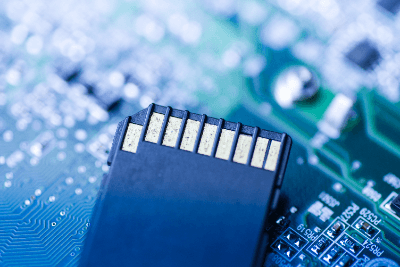What Is a Memory Card?

A memory card is a thin card-shaped auxiliary storage device.
Because memory cards are compact, rewritable, and consume little power, they are widely used as storage media in mobile information devices.
Uses of Memory Cards
Memory cards are used as recording media in a variety of electronic devices. For example, they are the recording media for various electronic devices, such as recording and storing image information in digital cameras and video cameras, storing data in smartphones, and recording music data in audio players.
Due to their low power consumption and small size and light weight, memory cards are also used as data storage devices in PCs and tablet terminals, and many PCs are equipped with memory card readers.
Principle of Memory Cards
Memory cards come in a variety of standards, but basically they consist of NAND flash memory and controller circuitry in a single package. The following features are available:
- High data write speed
- Low unit cost per capacity
- The circuit structure allows numerous memory elements (memory cells) to be arranged, making it easy to increase capacity through high integration.
This makes it suitable for large-capacity data storage. However, since the basic operation is block-by-block access, it is inevitable that the speed will be low when random access is performed.
In addition, the controller circuit will control reading/writing data to/from flash memory. On the other hand, flash memory has an upper limit to the number of rewrites, which in the case of NAND flash memory is said to be 100,000 times at most. The retention period of recorded data is also usually around 10 years.
Therefore, memory cards cannot escape this limitation. It is advisable to replace the memory card with a new one on a regular basis and to store the recorded data in a different recording device suitable for long-term storage.
Types of Memory Cards
Various types of memory cards have been proposed in the past, but these are now being consolidated into CF cards, SD cards, and microSD cards.
1. CF Cards
CompactFlash is a memory card standard developed by SanDisk. CF cards are generally referred to as CF cards, and since their electrical specifications are compatible with PC cards, they could once be used through a PC card slot with an adapter attached.
Since the input/output interface standard is ATA, a CF card can be regarded as a storage device similar to a hard disk drive by a PC.
2. CFexpress Card
CFexpress is the successor to CF cards, and its specifications were developed by CFA (CompactFlash Association), the organization that developed CF. Its greatest feature is its support for NVMe, a communication protocol used in PC SSDs and other devices.
The following three types of CFexpress are defined:
- Type B
Type B was the first to be put into practical use, with a maximum transfer rate of 16 Gbps. Its dimensions are 38.5 mm long, 29.6 mm wide, and 3.8 mm thick. It is used in the latest high-performance SLR cameras and mirrorless cameras. - Type A
Compact dimensions of 28mm long, 20mm wide, and 2.8mm thick. 1 x PCIe Gen.3, NVMe 1.3, and a transfer rate of 8Gbps are specified. - Type C
Although large at 74.5mm in length, 54.4mm in width, and 6.2mm in thickness, it has an extremely fast data transfer rate of 32Gbps thanks to PCIe Gen.3 x 4 and NVMe 1.3.
3. SD Memory Cards
A memory card standard jointly developed by SanDisk, Matsushita Electric Industrial, and Toshiba, SD memory cards are 24 mm long, 32 mm wide, and 2.1 mm thick, but have a large capacity of 1 TB. Another feature is the built-in copyright protection function CPRM (Content Protection for Recordable Media).
SD memory cards are classified according to their data transfer speed, and even the fastest SD memory cards can transfer data at 2 Gbps, which is about the same speed as CF cards, but not as fast as CFexpress cards. However, because they are small, easy to use, and inexpensive, they are widely used for general data storage.
4. MicroSD Card
The microSD card is a more compact version of the SD card. It is 15 mm long, 11 mm wide, and weighs only about 0.4 g. It can be used in mobile phones, smartphones, and tablets. They are used in cell phones, smartphones, tablets, digital audio players, etc.
5. SmartMedia
SmartMedia is a postage stamp-sized (37 mm wide, 45 mm long, 0.76 mm thick, and 1.8 g in weight) memory card standard proposed by Toshiba. It was widely used in digital cameras, PDAs, digital audio equipment, and game consoles.
6. MiniSD
A smaller version of the SD memory card, it was mainly used as a memory card for cell phones, but was replaced by the even smaller microSD card.
7. Multimedia Card
A memory card jointly developed by Siemens and SanDisk. SD cards are said to be an improved version of multimedia cards.
8. xD-Picture Card
A memory card standard jointly developed by Olympus Corporation and Fuji Photo Film Co. It was used for a while in digital cameras from both companies, but no manufacturer followed suit, and both companies have switched to SD cards and miniSD cards for their current products.
9. Memory Stick
A memory card with copyright protection proposed by Sony, Memory Stick has been used as a recording media for Sony PCs, digital cameras, and digital audio devices for quite a long time.
10. Memory Stick Duo
A smaller version of Memory Stick, this standard was developed as a recording media for cell phones. It was used in cell phones, digital cameras, DV camcorders, PSP, etc.
Various other memory cards have been used, but it is unlikely that they will be used in new devices anytime soon. Some of the most representative memory cards are listed above, but some have already been discontinued.